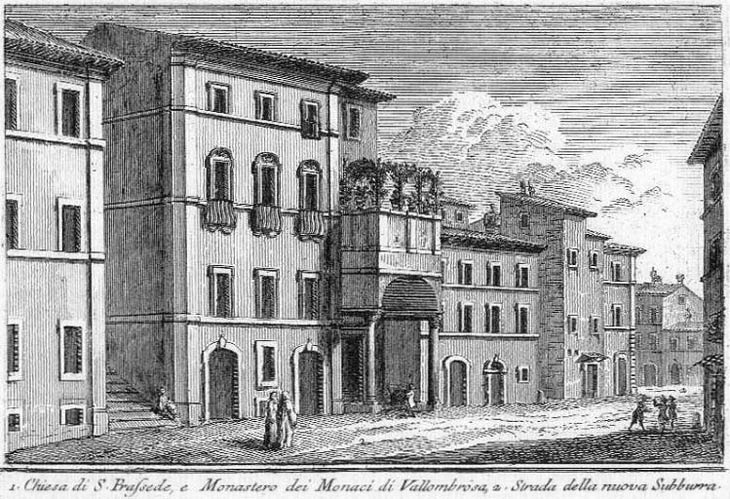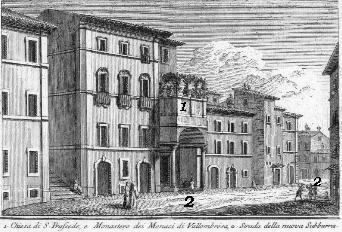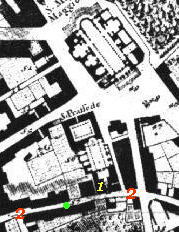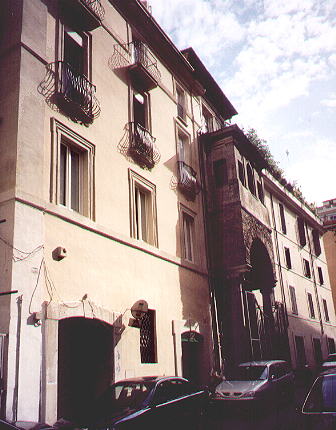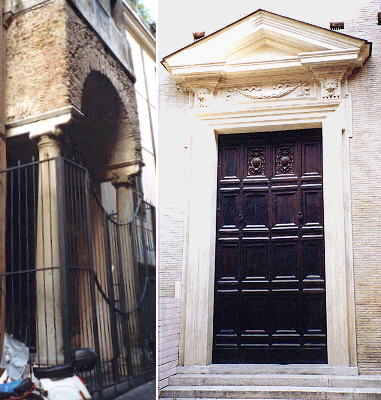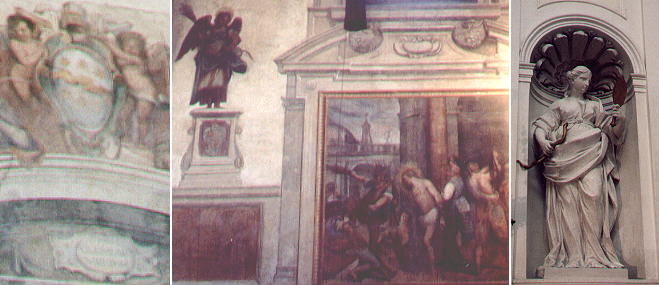

Chiesa di S. Prassede (Book
7) (Day
2) (View B8) (Rione Monti)
In this page:
The plate by Giuseppe Vasi
Today's view
S. Prassede
A Poem by Robert Browning
The Plate (No. 127 - ii)
S. Prassede is one of the few churches which are fully
encircled by houses. Only a little porch marks the entrance to the church. The view is taken from the green dot in the 1748 map below. In the description below the plate Vasi made reference to: 1) S. Prassede; 2) Strada della Nuova Suburra.
Today
Today the entrance is even less evident, because the
houses are now also above the porch. The building to the left of the entrance
is still the same. Via della Nuova Suburra linked the area of S. Maria Maggiore
with la Suburra the ancient Roman name given
to a quarter around Piazza alli Monti. The street is now called Via di S. Martino ai Monti.
S. Prassede
Many columns of the nearby Roman baths of Titus
and Trajan were used in several ways for building S. Prassede. The
porch has two elegant Ionian columns, but inside the church there is a
striking series of Corinthian columns (in my background). The porch is not the immediate entrance to the church:
as in the case with S. Clemente
the porch leads to a small courtyard where the main door of the church is located.
The interior of S. Prassede contains works of all periods, from medieval mosaics and Cosmati decoration to
Mannerist paintings and XVIIIth century statues. The image above shows the coat of arms of Clemens VIII by Agostino Ciampelli, a Flagellation by Paris Nogari and an XVIIIth century Prudence.
A Poem by Robert
Browning
Robert Browning and his wife Elizabeth Barret Browning spent many years in Rome. The following
poem shows how much he was acquainted with the different marbles and stones of Rome and it
portrays in an ironic way the importance given by Romans to their tomb.
You may wish to read it in
conjunction with a page on The Stones of Rome and pages on the Papal Monuments.
THE BISHOP ORDERS HIS TOMB
AT SAINT PRAXED'S CHURCH
Rome, 15 -
Vanity, saith the preacher, vanity!
Draw round my bed: is Anselm keeping back?
Nephews - sons mine... ah God, I know not! Well -
She, men would have to be your mother once,
Old Gandolf envied me, so fair she was!
What's done is done, and she is dead beside,
Dead long ago, and I am Bishop since,
And as she died so must we die ourselves,
and thence ye may perceive the world's a dream.
Life, how and what is it? As here I lie
In this state-chamber, dying by degrees,
Hours and long hours in the dead night, I ask
"Do I live, am I dead?" Peace, peace seems all.
Saint Praxed's ever was the church for peace;
And so, about this tomb of mine. I fought
With tooth and nail to save my niche, ye know:
- Old Gandolf cozened me, despite my care;
Shrewd was that snatch from out the corner South
He graced his carrion with, God curse the same!
Yet still my niche is not so cramped but thence
One sees the pulpit o' the epistle-side,
And somewhat of the choir, those silent seats,
And up into the airy dome where live
The angels, and a sunbeam's sure to lurk:
And I shall fill my slab of basalt there,
And 'neath my tabernacle take my rest,
With those nine columns round me, two and two,
The odd one at my feet where Anselm stands:
Peach-blossom marble (1) all, the rare, the ripe
As fresh-poured red wine of a mighty pulse.
- Old Gandolf with his paltry onion-stone (2),
Put me where I may look at him! True peach,
Rosy and flawless: how I earned the prize!
Draw close: that conflagration of my church
- What then? So much was saved if aught were
missed!
My sons, ye would not be my death? Go dig
The white-graped vineyard where the oil-press stood,
Drop water gently till the surface sink,
And if ye find... Ah God, I know not, I!..
Bedded in store of rotten fig-leaves soft,
And corded up in a tight olive-frail,
Some lump, ah God, of lapis lazuli,
Big as a Jew's head cut off at the nape,
Blue as a vein o'er the Madonna's breast...
Sons, all I have bequeathed you, villas, all,
That brave Frascati villa with its bath,
So, let the blue lump poise between my knees,
Like God the Father's globe on both his hands
Ye worship in the Jesu Church so gay,
For Gandolf shall not choose but see and burst!
Swift as a weaver's shuttle fleet our years:
Man goeth to the grave, and where is he?
Did I say basalt for my slab, sons? Black -
'Twas ever antique-black I meant! How else
Shall ye contrast my frieze to come beneath?
The bas-relief in bronze ye promised me,
Those Pans and Nymphs you wot of, and perchance
Some tripod, thyrsus, with a vase or so,
The Saviour at his sermon on the mount
Saint Praxed in a glory, and one Pan
Ready to twitch the Nymph's last garment off,
And Moses with the tables... but I know
Ye mark me not! What do they whisper thee,
Child of my bowels, Anselm? Ah, ye hope
To revel down my villas while I gasp
Bricked o'er with beggar's mouldy travertine
Which Gandolf from his tomb-top chuckles at!
Nay. boys, ye love me - all of jasper (3) then!
'Tis jasper ye stand pledged to, lest I grieve.
My bath must needs be left behind, alas!
One block, pure green as a pistachio-nut,
There's plenty jasper somewhere in the world -
And have I not Saint Praxed's ear to pray
Horses for ye, and brown Greek manuscripts,
And mistresses with great smooth marbly limbs?
- that's if ye carve my epitaph aright,
Choice Latin, picked phrase, Tully's every word,
No gaudy ware like Gandolf's second line -
Tully, my masters? Ulpian serves his need!
And then how I shall lie through centuries,
And hear the blessed mutter of the mass,
And see God made and eaten all day long,
And feel the steady candle-flame, and taste
Good strong thick stupefying incense-smoke!
For as I lie here, hours of the dead night,
Dying in state and by such slow degrees,
I fold my arms as if they clasped a crook,
And stretch my feet forth straight as stone can point,
And let the bedclothes, for a morthcloth, drop
Into great laps and folds of sculptor's-work:
And as yon tapers dwindle, and strange thoughts
Grow, with a certain humming in my ears,
About the life before I lived this life,
And this life too, popes, cardinals and priests,
Saint Praxed at his sermon on the mount,
Your tall pale mother with her talking eyes,
And new-found agate urns as fresh as day,
And marble's language, Latin pure, discreet,
- Aha, ELUSCEBAT quoth our friend?
No Tully, said I, Ulpian at the best!
Evil and brief hath been my pilgrimage.
All lapis, all, sons! Else I give the Pope
My villas! Will ye ever eat my heart?
Ever your eyes were as a lizard's quick,
They glitter like your mother's for my soul,
Or ye would heighten my impoverished frieze,
Piece out its starved design, and fill my vase
With grapes, and add a vizor and a Term,
And to the tripod ye would tie a lynx
That in his struggle throws the tyrsus down,
To comfort me on my entablature
Whereon I am to lie till I must ask
"Do I live?, am I dead?" There, leave me, there!
For ye have stabbed me with ingratitude
To death - ye wish it - God ye wish it! Stone -
Gritstone, a-crumble! Clammy squares which swear
As if the corpse they keep were oozing through -
And no more lapis to delight the world!
Well, go! I bless ye. Fewer tapers there,
But in a row: and, going, turn your backs
- Ay, like departing altar-ministrants,
And leave me in my church, the church for peace,
That I may watch at leisure if he leers -
Old Gandolf, at me, from his onion-stone,
As still he envied me, so fair she was!
(1) Maybe cottanello; (2) Cipollino; (3) Diaspro
|
Excerpts from Giuseppe Vasi 1761 Itinerary related to this page:
Chiesa di S. Prassede
Sulla medesima piazza di s. Maria Maggiore corrisponde quest'antichissima chiesa, eretta da s. Pio I.
circa l'anno 160. nelle Terme di Novato nel vicolo Laterizio ad istanza della santa Titolare, la quale in
tempo delle persecuzioni, quivi nella sua casa nascondeva, ed alimentava quanti Cristiani vi capitavano,
e per˛ aggravata di dolore, ed afflizione per vedere strapazzati tanti Cristiani in questo luogo medesimo,
se ne morý, e si vede in mezzo della chiesa un pozzo in cui si dice, che ponesse il sangue, e i corpi
de' ss. Martiri, e a sinistra della porta maggiore una gran pietra, sopra cui la santa Vergine dormiva, ed
affliggeva il suo corpo. ╚ in quella chiesa la celebre cappella di s. Zenone, detta prima Oratorio, poi
orto del Paradiso, ed ancora s. Maria libera nos a poenis inferni; e vi sono riposti i 230.
corpi di s. Martiri, e nell'altare, quello del medesimo s. Zenone con quello di s Valentino, e nella
cappelletta si custodisce la colonna, a cui fu legato il nostro divino Salvatore mentre fu flagellato,
e per˛ non Ú lecito alle donne di entrarvi. Da Pasquale I. fu eretta di nuovo, e fu ornata di mosaici
circa l'anno 822. .
Quindi s. Carlo Borromeo, essendone Titolare, rinnov˛ la chiesa, e vi fece il tabernacolo ornato con quattro
colonne di porfido, mentre da principio era tutto di argento massiccio, e dall'una, e dall'altra parte vi pose le
statue di s. Prassede, e di s Pudenziana, i corpi delle quali stanno sotto il medesimo altrare. Il Card. Alessandro
Medici, che fu poi Papa Leone XI. fece dipingere nella nave di mezzo li misteri della passione del nostro
Redentore; l'orazione all'orto, e la Croce in collo, con anche gli angioli, e li otto Apostoli fu i pilastri sono di
Gio: Francesco Cosci Fiorentino; il Ges¨ condotto da Pilato, di Girolamo Maffei; la coronazione di spine, di
Baldassare Croce; l'Ecce Homo del Ciampelli; nell'altro vi oper˛ Paris Nogari ed altri, e i chiari scuri in tinta gialla
li lavor˛ Cesare Rosetti. La ss. Nunziata sopra la porta con Apostoli e putti sono di Stefano Pieri, e le pitture nella
porta di fianco del Ciampelli. Il santo Abate nella prima cappella a destra si crede dell'Alberti; il Cristo morto in
quella, che siegue, Ŕ di Giovanni de' Vecchi, la volta, di Guglielmo Borgognone, e i due laterali, di Ciro Ferri, mentre
era giovane; il quadro con Ges¨ Cristo alla colonna nella santa cappella Ŕ opera di Giulio Romano, e quello, che si
vede in sagrestia col ss. Crocifisso, e due Santi inginocchioni sono del Ciampelli; il quadro nella cappella che
siegue, Ŕ di Guglielmo Cortese, quello dell' altra, di Federigo Zuccheri, e la volta del Cav. d'Arpino. Custodiscono
questa chiesa i Monaci di Valombrosi, i quali godono ancora le stanze de' Cardinali Titolari, nelle quali abit˛ s.
Carlo Borromeo quando dimorava in Roma.
Resta questa chiesa voltata non giÓ verso la piazza di s. Maria Maggiore, ma verso la nuova strada della Suburra,
che forse sarÓ l'antico vicolo Laterizio, e vi si vede l'umile portico sostenuto da due rozze colonne.
|
Next plate in Book 7: Chiesa di S. Bernardo alle Terme
Next step in Day 2 itinerary: Chiesa dei SS. Silvestro e Martino ai Monti
Next step in your tour of Rione Monti: Chiesa dei SS. Silvestro e Martino ai Monti

Go
to  or to Book
7 or to my Home
Page on Baroque Rome or to my Home Page on Rome
in the footsteps of an XVIIIth century traveller.
or to Book
7 or to my Home
Page on Baroque Rome or to my Home Page on Rome
in the footsteps of an XVIIIth century traveller.
|


